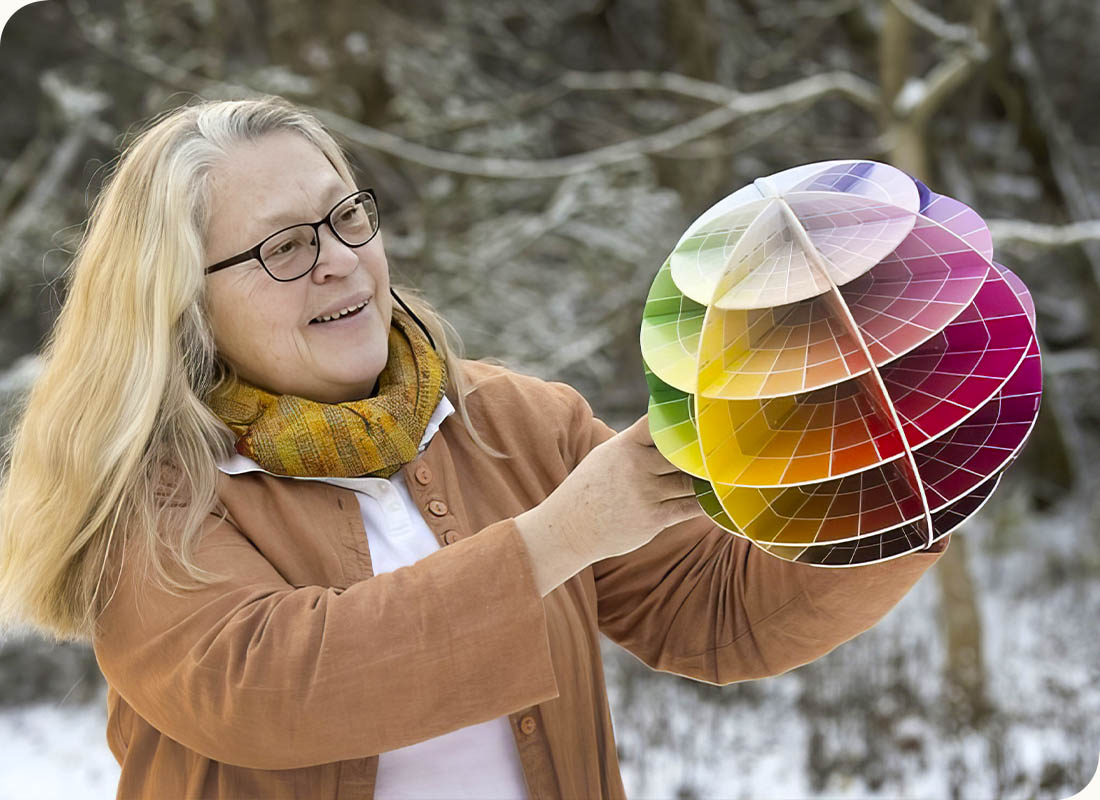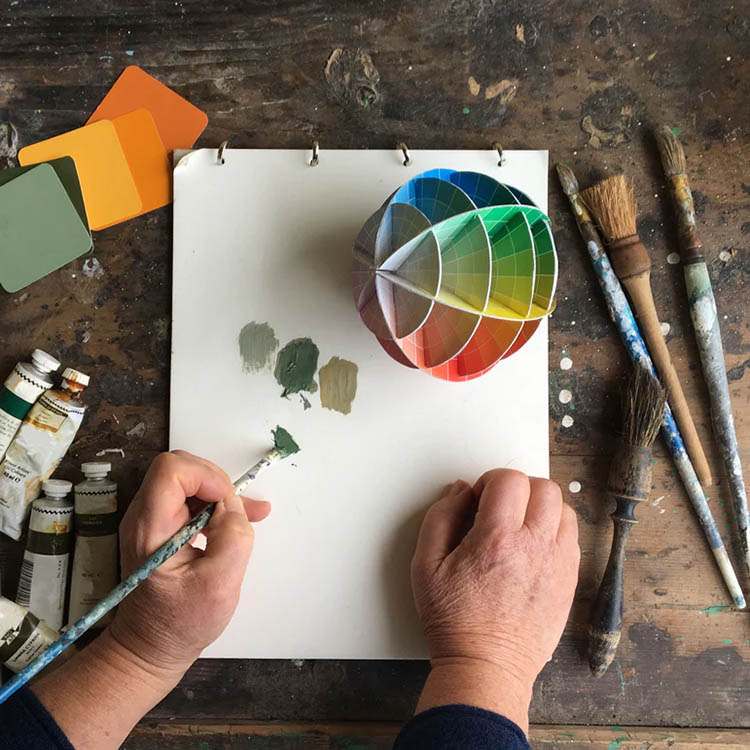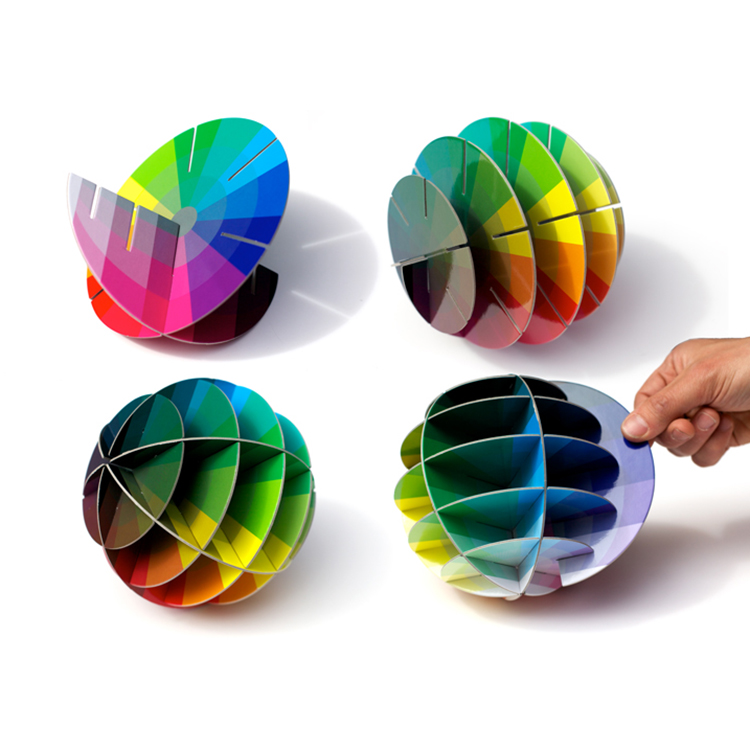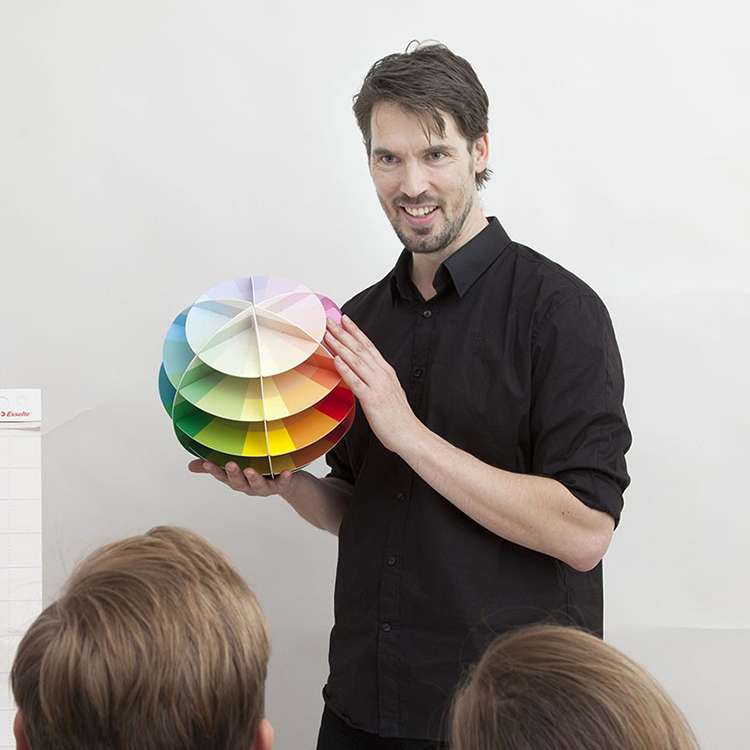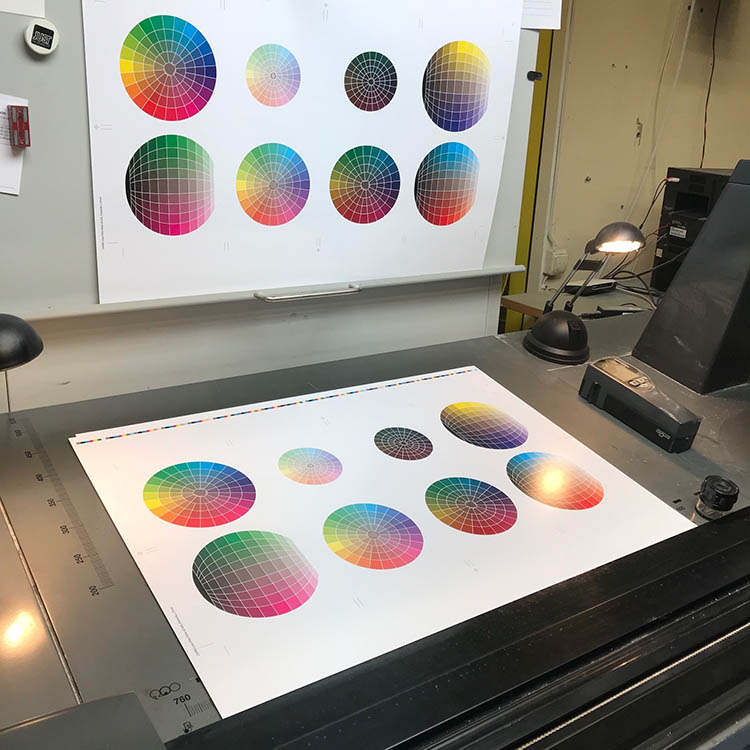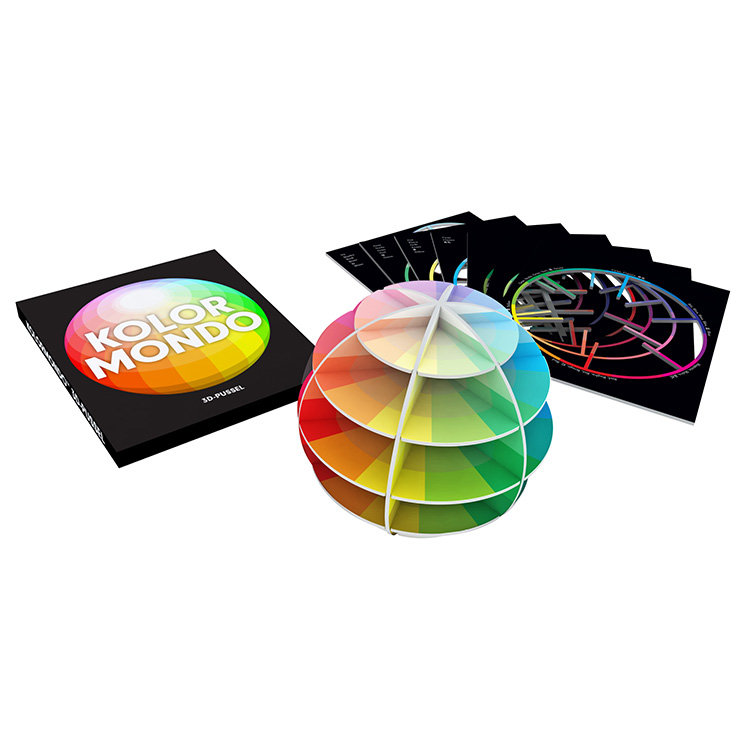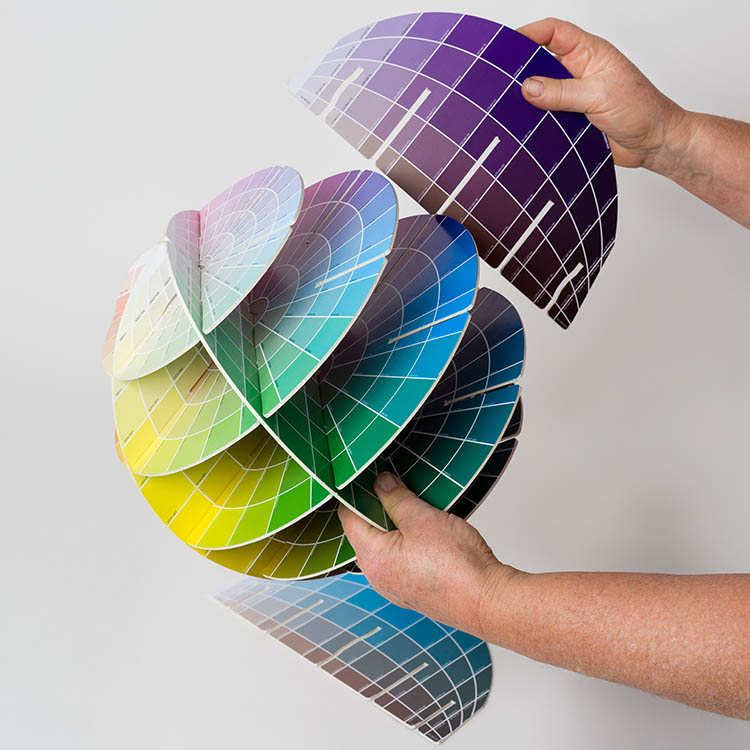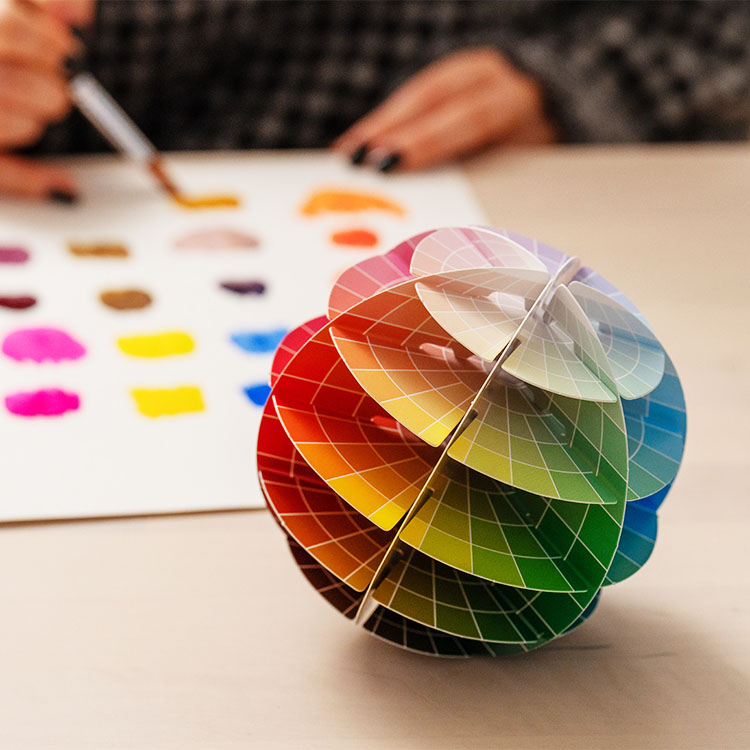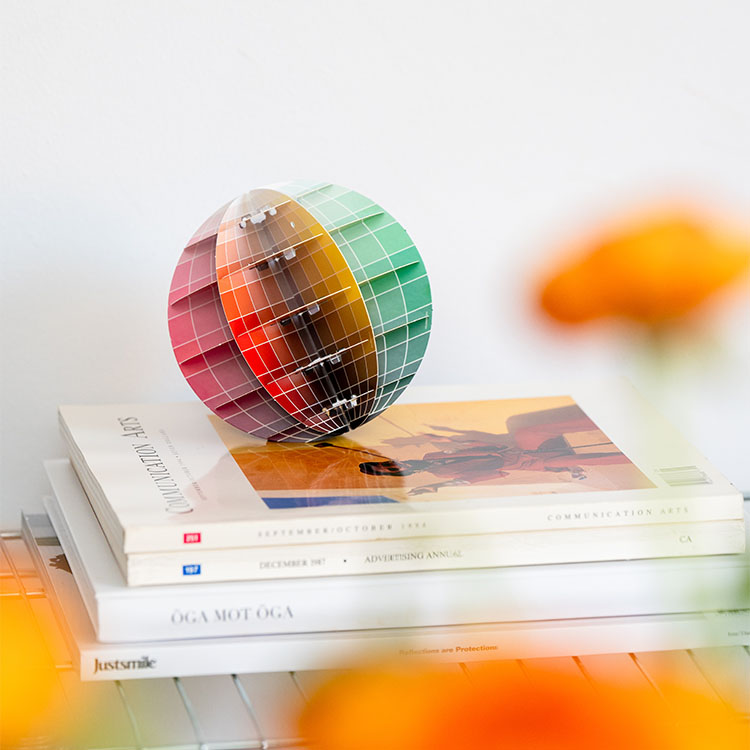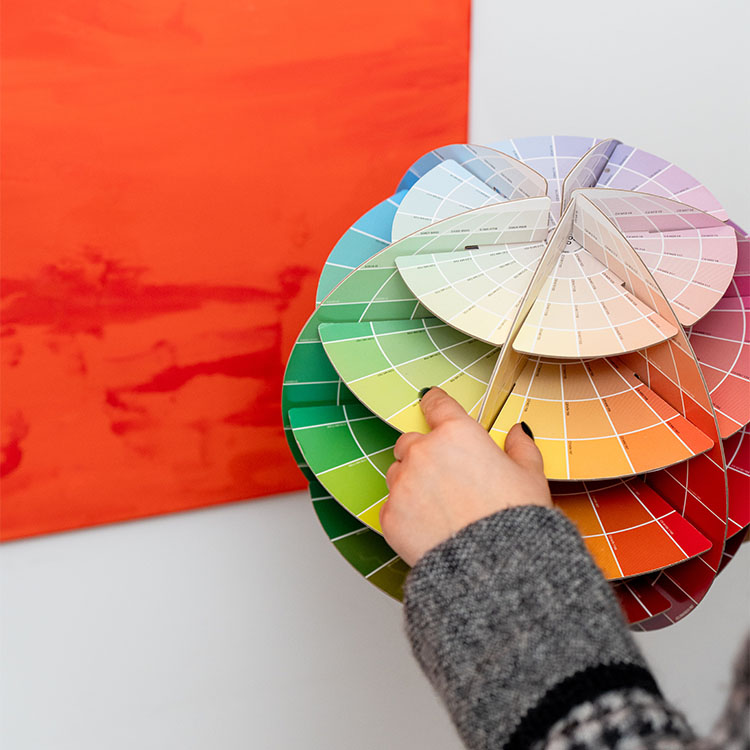A journey in the world of colors
A colorful discovery
In a weekend course on color theory, Nicoline began navigating the complexities of color with new understanding and appreciation. The course introduced participants to Johannes Itten's Bauhaus-era color star, which explores how colors interact with and influence each other. By starting with the primary colors blue, red and yellow in a circle and gradually mixing them to create secondary and tertiary shades, and then adjusting the brightness by adding white or black, they completed the color circle with a spectrum of colors.
"It was when we painted the color star that I had my aha moment. The colors suddenly had a clear relationship with each other."
The teacher explained that if the star were to be shaped into a sphere, the relationship between the colors would become even more visible. In such a 3D model, it would be possible to see how the colors transformed along the latitudes and longitudes, but also how the colors met at the center of the sphere. Around the equator of the color globe, the primary colors would emerge, and by moving up or down, the brightness would change, while the saturation would become clearer if you moved from the gray center towards the globe's surface. For some it was obvious, for Nicoline it was an eye-opener. What the teacher was talking about was only a theoretical concept that did not exist, but for Nicoline an idea had already started to take shape - a three-dimensional color guide, a miniature color world.
From fruit to phenomenon
With some glue and imagination, Nicoline attached her color star to a dried clementine, and Kolormondo's first prototype was born. But transforming an idea into a tangible product is rarely a journey without challenges, and for Nicoline, the starting line was quickly filled with question marks. In what form and from what material would the idea be realized? In what size and with how many colors? And not least, who was the intended customer? The product had to be compact enough to be easily shipped, robust enough to withstand the occasional admiring glance and light enough for anyone to pick up and study.
Through the Stockholm Circle of Innovators, Nicoline came into contact with industrial designer Jonas Ahnmé, now Head of Department at Konstfack, who played an invaluable role in the development of the project. As a sounding board and mentor, he contributed both creative insight and practical advice, and his experience and knowledge of art and design were crucial to finding the right way forward. Jonas introduced Nicoline to Daniel Bjurgård, the graphic designer whose vision for Kolormondo helped bring the idea from the concept stage to a concrete product.
When Kolormondo first took shape, the ambition was to create a magnetic 3D model - the idea of magnetic parts was appealing for its ease of use, with each color segment easily attached to and removed from the model. But this would make the product both expensive and cumbersome, limiting its accessibility and practicality, especially for younger users or in educational contexts where agility is crucial. Daniel Bjurgård came up with the brilliant idea of horizontal and vertical pieces that fit together like a puzzle. And so it was natural to choose recyclable cardboard, which does not compromise the quality of the product or the user experience. The bonus? Flat packaging that hardly takes up any space.
Until today, it has been difficult to produce exact color pigments. Traditionally, red, yellow and blue have been the three basic colors that have been used. Itten and the old masters who captured the ideas of a color globe therefore used these as primary colors. Today, cyan-blue, magenta-red and yellow (CMY) are the standard. And it was only when the designers behind Kolormondo started using CMY that it was possible to produce a comprehensive color image where all colors gradually merge in all directions - up, down, inwards, outwards and sideways.
For all color enthusiasts
It was initially not entirely clear who would be the users of this colorful creation. But despite initial difficulties in communicating the product's purpose and uses, it has found its audience. Much thanks to Nicoline's unwavering determination and persistent commitment. Today, Kolormondo is mainly used in educational contexts, from pre-school education to university studies, covering a wide range of subjects, including product design, fashion, art history, architecture, graphic design and print production.
Kolormondo has also proved useful in a number of unexpected and unique contexts - including a sugar refinery, which needs to accurately measure the color changes of sugar beet during the refining process. Hairdressers have also emerged as one of the largest user groups, as they need to understand color theory to achieve the precise shades that customers demand. But Kolormondo's relevance extends beyond school classrooms, hairdressers, sugar refineries and other color-sensitive industries, and is an eye-opener for anyone who wants to explore and understand the interplay of colors.
"By visualizing colour relationships in an easy-to-understand way, I have created a tool that makes a grey day never feel grey."
Kolormondo has also found its niche and carved out its place on the international stage, with a particular shine in the US and UK where no less than four patents shine in its name. But it is in Berlin's Bauhaus Museum that the color-matching globe came into its own and confirmed its success as a perennial hit.
A colorful history
It is often the small moments of wonder and curiosity that lead to the big breakthroughs, and this is the case for Nicoline Kinch. Sometimes all you need is an idea, a little curiosity and the courage to explore. That and a lot of stubbornness.
Tips for other innovators
Nicoline's tips for other innovators:
Don't be afraid to showcase your idea. It is in meeting with others that innovations take shape. Actively accepting help and advice can give your idea the boost it needs. The risk of having your idea stolen is negligible.A colorful discovery
In a weekend course on color theory, Nicoline began navigating the complexities of color with new understanding and appreciation. The course introduced participants to Johannes Itten's Bauhaus-era color star, which explores how colors interact with and influence each other. By starting with the primary colors blue, red and yellow in a circle and gradually mixing them to create secondary and tertiary shades, and then adjusting the brightness by adding white or black, they completed the color circle with a spectrum of colors.
"It was when we painted the color star that I had my aha moment. The colors suddenly had a clear relationship with each other."
The teacher explained that if the star were to be shaped into a sphere, the relationship between the colors would become even more visible. In such a 3D model, it would be possible to see how the colors transformed along the latitudes and longitudes, but also how the colors met at the center of the sphere. Around the equator of the color globe, the primary colors would emerge, and by moving up or down, the brightness would change, while the saturation would become clearer if you moved from the gray center towards the globe's surface. For some it was obvious, for Nicoline it was an eye-opener. What the teacher was talking about was only a theoretical concept that did not exist, but for Nicoline an idea had already started to take shape - a three-dimensional color guide, a miniature color world.
From fruit to phenomenon
With some glue and imagination, Nicoline attached her color star to a dried clementine, and Kolormondo's first prototype was born. But transforming an idea into a tangible product is rarely a journey without challenges, and for Nicoline, the starting line was quickly filled with question marks. In what form and from what material would the idea be realized? In what size and with how many colors? And not least, who was the intended customer? The product had to be compact enough to be easily shipped, robust enough to withstand the occasional admiring glance and light enough for anyone to pick up and study.
Through the Stockholm Circle of Innovators, Nicoline came into contact with industrial designer Jonas Ahnmé, now Head of Department at Konstfack, who played an invaluable role in the development of the project. As a sounding board and mentor, he contributed both creative insight and practical advice, and his experience and knowledge of art and design were crucial to finding the right way forward. Jonas introduced Nicoline to Daniel Bjurgård, the graphic designer whose vision for Kolormondo helped bring the idea from the concept stage to a concrete product.
When Kolormondo first took shape, the ambition was to create a magnetic 3D model - the idea of magnetic parts was appealing for its ease of use, with each color segment easily attached to and removed from the model. But this would make the product both expensive and cumbersome, limiting its accessibility and practicality, especially for younger users or in educational contexts where agility is crucial. Daniel Bjurgård came up with the brilliant idea of horizontal and vertical pieces that fit together like a puzzle. And so it was natural to choose recyclable cardboard, which does not compromise the quality of the product or the user experience. The bonus? Flat packaging that hardly takes up any space.
Until today, it has been difficult to produce exact color pigments. Traditionally, red, yellow and blue have been the three basic colors that have been used. Itten and the old masters who captured the ideas of a color globe therefore used these as primary colors. Today, cyan-blue, magenta-red and yellow (CMY) are the standard. And it was only when the designers behind Kolormondo started using CMY that it was possible to produce a comprehensive color image where all colors gradually merge in all directions - up, down, inwards, outwards and sideways.
For all color enthusiasts
It was initially not entirely clear who would be the users of this colorful creation. But despite initial difficulties in communicating the product's purpose and uses, it has found its audience. Much thanks to Nicoline's unwavering determination and persistent commitment. Today, Kolormondo is mainly used in educational contexts, from pre-school education to university studies, covering a wide range of subjects, including product design, fashion, art history, architecture, graphic design and print production.
Kolormondo has also proved useful in a number of unexpected and unique contexts - including a sugar refinery, which needs to accurately measure the color changes of sugar beet during the refining process. Hairdressers have also emerged as one of the largest user groups, as they need to understand color theory to achieve the precise shades that customers demand. But Kolormondo's relevance extends beyond school classrooms, hairdressers, sugar refineries and other color-sensitive industries, and is an eye-opener for anyone who wants to explore and understand the interplay of colors.
"By visualizing colour relationships in an easy-to-understand way, I have created a tool that makes a grey day never feel grey."
Kolormondo has also found its niche and carved out its place on the international stage, with a particular shine in the US and UK where no less than four patents shine in its name. But it is in Berlin's Bauhaus Museum that the color-matching globe came into its own and confirmed its success as a perennial hit.
A colorful history
It is often the small moments of wonder and curiosity that lead to the big breakthroughs, and this is the case for Nicoline Kinch. Sometimes all you need is an idea, a little curiosity and the courage to explore. That and a lot of stubbornness.
Tips for other innovators
Nicoline's tips for other innovators:
Don't be afraid to showcase your idea. It is in meeting with others that innovations take shape. Actively accepting help and advice can give your idea the boost it needs. The risk of having your idea stolen is negligible.